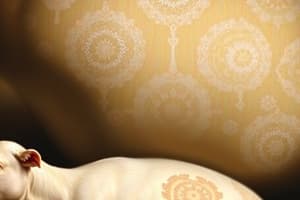Podcast
Questions and Answers
What are the histological changes in the mammary gland that occur during lactation compared to its inactive state?
What are the histological changes in the mammary gland that occur during lactation compared to its inactive state?
- Increased amount of adipose tissue
- Reduction in the number of lobes
- Increased connective tissue density
- Development of secretory alveoli (correct)
Which hormonal regulation primarily triggers milk secretion during lactation?
Which hormonal regulation primarily triggers milk secretion during lactation?
- Follicle-stimulating hormone (FSH)
- Estrogen
- Luteinizing hormone (LH)
- Prolactin (correct)
What structural changes occur in the mammary gland during the involution phase after nursing has ceased?
What structural changes occur in the mammary gland during the involution phase after nursing has ceased?
- Increase in glandular tissue
- Development of more lactiferous ducts
- Replacement of secretory cells with adipose tissue (correct)
- Formation of new lobules
What is the primary function of lactiferous ducts in the mammary gland?
What is the primary function of lactiferous ducts in the mammary gland?
Which secretion mechanism is primarily responsible for milk expulsion during nursing?
Which secretion mechanism is primarily responsible for milk expulsion during nursing?
What histological change is most characteristic of the mammary gland during pregnancy compared to its inactive state?
What histological change is most characteristic of the mammary gland during pregnancy compared to its inactive state?
Which structure serves as a storage area for milk between nursing sessions?
Which structure serves as a storage area for milk between nursing sessions?
What characterizes the mammary gland during pregnancy compared to its inactive state?
What characterizes the mammary gland during pregnancy compared to its inactive state?
What is the primary functional role of the mammary gland?
What is the primary functional role of the mammary gland?
Which component is involved in the mechanism of milk secretion?
Which component is involved in the mechanism of milk secretion?
Which hormones primarily control the secretory activity of the mammary gland during breastfeeding?
Which hormones primarily control the secretory activity of the mammary gland during breastfeeding?
During involution of the mammary gland, which change occurs?
During involution of the mammary gland, which change occurs?
What is a primary histological change observed in the lactating mammary gland?
What is a primary histological change observed in the lactating mammary gland?
Which hormonal action is primarily responsible for initiating lactation?
Which hormonal action is primarily responsible for initiating lactation?
How does the mammary gland structure differ in males compared to females before puberty?
How does the mammary gland structure differ in males compared to females before puberty?
What type of gland is the mammary gland classified as?
What type of gland is the mammary gland classified as?
Which type of epithelium primarily lines the inner layer of the terminal ductules?
Which type of epithelium primarily lines the inner layer of the terminal ductules?
What is the primary tissue filling the spaces between lobules in the mammary gland?
What is the primary tissue filling the spaces between lobules in the mammary gland?
What is the evolutionary classification of the mammary gland?
What is the evolutionary classification of the mammary gland?
Which statement accurately describes the secretion mechanism associated with follicular hormones?
Which statement accurately describes the secretion mechanism associated with follicular hormones?
Which layer surrounds the lobules of the mammary gland?
Which layer surrounds the lobules of the mammary gland?
Flashcards are hidden until you start studying
Study Notes
Mammary Gland Functions and Structure
- Mammary glands function as lactating glands using merocrine and apocrine secretion to produce milk.
- Milk is temporarily stored in lactiferous ducts and expelled during nursing through smooth muscle in the nipple.
- Sebaceous glands are abundant around the nipple area, contributing to skin lubrication.
- The gland reverts to an inactive state once nursing ceases.
- Age-related changes result in adipose tissue being replaced by dense irregular connective tissue.
- Pathological changes can lead to the development of mammary carcinomas.
Histological Components of the Mammary Gland
- Identify structures associated with the nipple and areola: lobes, lobules, secretory alveoli (acini), and lactiferous ducts.
- Learn the organization into interlobular and intralobular connective tissue.
- Differences in histology observed in adult females: inactive (before pregnancy), active (during pregnancy), and lactating (after pregnancy).
Development and Hormonal Regulation
- The mammary gland is a modified apocrine sweat gland that develops under the influence of estrogen while testosterone inhibits development in males.
- Before puberty, mammary gland structures in males and females are indistinguishable.
- Secretory activity during pregnancy and lactation is controlled by hormones such as prolactin from the pituitary gland and ovarian hormones.
Structural Changes During Life Stages
- In an inactive mammary gland:
- Glandular tissue is underdeveloped; primarily consists of duct elements.
- Terminal ductules connect to intralobular ducts leading to larger ducts.
- During pregnancy:
- Glandular elements become more developed with reduced interlobular connective tissue.
- In a lactating mammary gland:
- Very little interlobular connective tissue remains, indicating high secretory activity.
Studying That Suits You
Use AI to generate personalized quizzes and flashcards to suit your learning preferences.




